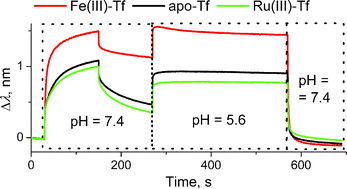Bio-Layer Interferometry (BLI) is an optical analytical technique which measures the changes in light reflectance from an optical surface caused by macromolecule bindings to reveal the biomolecular interactions with interactome.
Dr. Aviva Levina and Prof. Peter A. Lay from the University of Sydney reported the first application of BLI technique into the studies of influences of medicinal metal ions on extracellular protein-protein interactions (PPIs). Their research shed light into the mechanism of the anti-metastatic activity of Ru(III) prodrugs.
In the PPI study on transferrin (Tf) with transferrin receptor 1 (TfR1), BLI was used to study the full cycle of Tf-TfR1 binding and dissociation in a single experiment and proved to be a simper and faster option for assessing the TfR1 binding for various metal-Tf complexes. Results of Tf-TfR1 binding studies suggest that blocking of Fe(III) delivery to fast-metabolising cancer cells through Ru(III)–Tf binding may be one of the mechanisms of anti-cancer activity of Ru(III), while the research on IgG–HSA binding supports the hypothesis that cross-linking of extracellular proteins by Ru(III) is involved in its anti-metastatic activity.

Typical BLI response curves for the binding and dissociation of human Tf to recombinant human TfR1 in the presence or absence of metal ions
To find out more details, read this HOT InorgChemFrontiers article for FREE today!
Aviva Levina and Peter A. Lay
Inorg. Chem. Front., 2014, Advance Article
DOI: 10.1039/C3QI00054K










